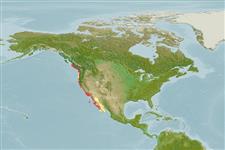Teleostei (teleosts) >
Scombriformes (Mackerels) >
Stromateidae (Butterfishes)
Etymology: Peprilus: Greek, peprilos, paprax, certain fish from Tracia.
More on author: Ayres.
Environment: milieu / climate zone / depth range / distribution range
Ecology
Marine; benthopelagic; depth range 9 - 91 m (Ref. 2850). Subtropical; 52°N - 23°N, 129°W - 109°W
Northeast Pacific: Queen Charlotte Sound in British Columbia, Canada to southern Baja California Sur and the Gulf of California. Occurrence in Nicaragua needs verification.
Size / Weight / Age
Maturity: Lm ? range ? - ? cm
Max length : 28.0 cm SL male/unsexed; (Ref. 9346)
Commonly found on sand bottom of exposed coasts. Usually occurs in shallow water near shore and often forms small, but fairly dense, schools (Ref. 4563).
Life cycle and mating behavior
Maturity | Reproduction | Spawning | Eggs | Fecundity | Larvae
Eschmeyer, W.N., E.S. Herald and H. Hammann, 1983. A field guide to Pacific coast fishes of North America. Boston (MA, USA): Houghton Mifflin Company. xii+336 p. (Ref. 2850)
IUCN Red List Status (Ref. 130435: Version 2024-1)
Threat to humans
Harmless
Human uses
Fisheries: commercial; gamefish: yes
Tools
Special reports
Download XML
Internet sources
Estimates based on models
Preferred temperature (Ref.
123201): 8.3 - 21, mean 10.1 °C (based on 54 cells).
Phylogenetic diversity index (Ref.
82804): PD
50 = 0.5020 [Uniqueness, from 0.5 = low to 2.0 = high].
Bayesian length-weight: a=0.01259 (0.00663 - 0.02390), b=3.11 (2.95 - 3.27), in cm total length, based on LWR estimates for this species & Genus-body shape (Ref.
93245).
Trophic level (Ref.
69278): 4.0 ±0.2 se; based on size and trophs of closest relatives
Resilience (Ref.
120179): High, minimum population doubling time less than 15 months (Assuming tm=1).
Fishing Vulnerability (Ref.
59153): Low vulnerability (24 of 100).
Climate Vulnerability (Ref.
125649): Moderate to high vulnerability (50 of 100).
Nutrients (Ref.
124155): Calcium = 74.1 [35.3, 186.2] mg/100g; Iron = 0.895 [0.407, 1.915] mg/100g; Protein = 17.7 [15.9, 19.4] %; Omega3 = 0.329 [0.174, 0.615] g/100g; Selenium = 32.1 [14.4, 75.4] μg/100g; VitaminA = 11.2 [2.6, 44.7] μg/100g; Zinc = 0.669 [0.409, 1.104] mg/100g (wet weight);
